风景园林专业英语试题
- 格式:docx
- 大小:48.77 KB
- 文档页数:14
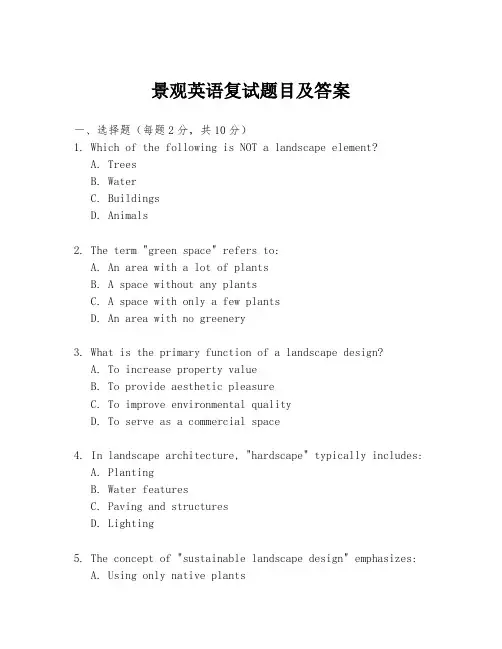
景观英语复试题目及答案一、选择题(每题2分,共10分)1. Which of the following is NOT a landscape element?A. TreesB. WaterC. BuildingsD. Animals2. The term "green space" refers to:A. An area with a lot of plantsB. A space without any plantsC. A space with only a few plantsD. An area with no greenery3. What is the primary function of a landscape design?A. To increase property valueB. To provide aesthetic pleasureC. To improve environmental qualityD. To serve as a commercial space4. In landscape architecture, "hardscape" typically includes:A. PlantingB. Water featuresC. Paving and structuresD. Lighting5. The concept of "sustainable landscape design" emphasizes:A. Using only native plantsB. Minimizing environmental impactC. Prioritizing human needsD. Maximizing profit答案:1. D2. A3. C4. C5. B二、填空题(每空1分,共10分)1. The process of creating a landscape design is known as______.2. A landscape that is designed to blend with its natural surroundings is often referred to as a(n) ______ landscape.3. The use of plants to create privacy or to screen unwanted views is known as ______.4. The term "ecological footprint" refers to the amount of ______ needed to support a lifestyle.5. A landscape that is designed with a focus on water conservation and the use of drought-resistant plants is called a ______ landscape.答案:1. Landscape design2. Naturalistic3. Screening4. Resources5. Xeriscaping三、简答题(每题5分,共20分)1. What are the three main components of a landscape design?2. Describe the role of a landscape architect in a project.3. Explain the importance of biodiversity in landscape design.4. Discuss the concept of "place-making" in landscape architecture.答案:1. The three main components of a landscape design are vegetation, hardscape, and water features.2. A landscape architect plays a crucial role in a project by creating plans that are both aesthetically pleasing and functional, considering environmental factors and the needsof the users.3. Biodiversity in landscape design is important as it contributes to the health of ecosystems, supports a varietyof life forms, and enhances the visual appeal of the landscape.4. "Place-making" in landscape architecture refers to the process of creating spaces that are meaningful and memorable, fostering a sense of identity and community among users.四、论述题(每题15分,共30分)1. Discuss the impact of climate change on landscape design and how landscape architects can adapt their practices to mitigate these effects.2. Elaborate on the principles of sustainable landscapedesign and provide examples of how these principles can be applied in urban settings.答案:1. Climate change impacts landscape design by causing shifts in plant hardiness zones, altering precipitation patterns, and increasing the frequency of extreme weather events. Landscape architects can adapt by selecting climate-resilient plants, designing for water management, and incorporating flexible design elements that can accommodate changing conditions.2. The principles of sustainable landscape design include reducing resource consumption, promoting biodiversity, and creating regenerative spaces. In urban settings, these principles can be applied by using permeable paving to reduce runoff, integrating green roofs and walls to increase green space, and designing landscapes that support local ecosystems and reduce the urban heat island effect.。
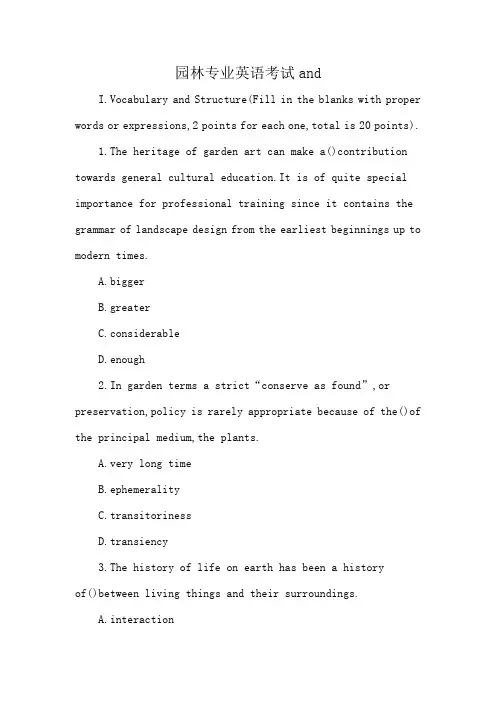
园林专业英语考试andI.Vocabulary and Structure(Fill in the blanks with proper words or expressions,2 points for each one,total is 20 points).1.The heritage of garden art can make a()contribution towards general cultural education.It is of quite special importance for professional training since it contains the grammar of landscape design from the earliest beginnings up to modern times.A.biggerB.greaterC.considerableD.enough2.In garden terms a strict“conserve as found”,or preservation,policy is rarely appropriate because of the()of the principal medium,the plants.A.very long timeB.ephemeralityC.transitorinessD.transiency3.The history of life on earth has been a historyof()between living things and their surroundings.A.interactionB.relation ofC.relationshipD.connection4.()the whole span of earthly time,the opposite effect,in which life actually modifies its surroundings,has been relatively slight.A.HoweverB.ConsideringC.InspiteD.Although5.Considered as materials,all plants have definite potentialities and each plant has an inherent quality which will inevitably express itself.An intelligent landscape design can evolve only()a profound knowledge of,and sensitivity to,materials.A.fromB.betweenC.amongD.upon6.The layout of these landscape designs may have survived,but the planting will have changed many times through age and fashion,and because the provision for planting did notfavour the()of the plants.A.productionB.yieldC.reproductionD.regeneration7.These steps of the design process represent an ideal sequence of events.Many of the()overlap one another and blend together so the neat ordering of the outline is less clear and apparentA.foot paceB.stepsC.stepdder8.Each project represents a unique set of circumstances and,therefore,()a different method for proceeding through the design process.A.requiredB.requiresC.requireD.requiring9.Park projects would civilize and()the national character,foster the love of rural beauty and increase theknowledge of and taste for rare and beautiful trees and plants.A.refinedB.refineC.designedD.design10.The case for public parks in the 19th century was built largely on the same concerns()that for improved housing.A.soB.intoC.asD.likeII.True or False Questions.(Select T if the statement is true,select F if it is false.2 points for each one,total is 10 points).11.ICOM is the abbreviation of International Council of Museums.()A.TB.F12.UNESCO is the abbreviation of United Nations Educational,Scientific and Cultural Organization.()A.TB.F13.The IInd International Congress of Architects and Technicians of Historic Monuments,which met in Venice from May 25th to 31st 1964.()A.TB.F14.As the new day breaks,the city lights fade,overpowered by the light of the sun;blue seas and green forests and grasslands emerge,surrounding and penetrating the vast urban constellations.()A.TB.F15.In the preliminary master plan all elements of the design are put together and studied in association with one another in a realistic,semicomplete graphic manner.()A.TB.FIII.Cloze test(Please fill in the blanks of the following passages with proper words or phases given below.2 points for each one,total is 20 points).1.As an(16),the extent and type of information sought during the site analysis should directly(17)on the character and complexity of concepts prepared in a later phase.Likewise,one may find it necessary to revisit the site or talk to the(18)again once the design phase itself has been started because some item of information was overlooked the first time or one’s memory and(19)simply need refreshing.And sometimes it helps to revisit the site after starting the design phase because then the designer can look at the site with experience and greater understanding of what limitations or opportunities are present.In other words,no one step of the(20)process occurs independently of the others.A.designB.impressionC.dependD.illustrationE.client2.While the practitioners of the English(21)of Landscape were using a limited range of plant species,a few botanical gardens and,of course,the traditional cottage(22)contained a wider range.Certainly by the end of the first quarter of the 18th century,the importation of exotics into Britain from abroad had(23),especially from North American.In 17XX the collection at Whitton,near Hounslow,listed 342 different plant species,and by 1768 the Royal garden at Kew had over 3000different(24)with the precise figure of 5535 in 17XX.More interesting to planting design,however,was the record of Dr.John Fothergill’s garden laid out in 1762 at Upton House,East Ham,because this included a wild area in which hardy exotics successfully naturalized.Dr.Fothergill also(25) alpine plants.F.gardenmencedH.SchoolI.cultivatedJ.speciesIV.Reading comprehension questions(2 points for each one,total is 20 points).1.Questions 26 to 30 are based on the following passage.In 1887 a professor of mental and moral philosophy,Grant Allen,published an analysis of aesthetics called Physiological Aesthetics.Today this little classic is virtually forgotten, but if a copy can be found,I commend it to all.The aesthetic conclusions were geared to the emotions of the day and to us now seem horribly sentimental,but the scientific method is unanswerable.It explains the hostility of modern man to what he feels is a soul-less,machine-made environment,and is a basicguide to landscape.From this primitive treasure house my own first choice is the power of stereoscopic vision to create feeling as well as sight in environment,how we can and should design for it,and how a felt foreground will connect our psyche to middle and far distance.But of course the perceptions are only a technical part in the long manufacture of the emotions in that marvellous green and restless habitat.In a period described as the golden age of the mammals,we were vegetarian, peace-loving and monarchs.No wonder the irrational parts of us hanker for that carefree if cruel existence,which created our basic sense of beauty and subconsciously inspires most private gardens today.26.A good title for this passage is().A.Physiological aestheticsB.Aesthetic development in landscape architectureC.the history of physiological aesthetics.D.the history of landscape.27.The word“geared”in the paragraph means().A.To become adjusted so as to fit or blendB.To equip with gears.C.To connect by gears.D.To put into gear.28.The word“stereoscopic”in the paragraph means().A.relating to seeing space three-dimensionally as a result of binocular disparity.B.formed by a stereoscopeC.relating to a stereoscopeD.of a stereoscope29.The word“vegetarian”in the paragraph means().A.a person who advocates or practises vegetarianismB.CookeryC.consisting of vegetables and fruit onlyD.Consisting primarily or wholly of vegetables and vegetable products30.The word“monarch”in the paragraph means().A.peopleB.humanC.studentD.animal2.Questions 31 to 35 are based on the following passage.Ruins must be maintained and measures necessary for the permanent conservation and protection of architectural features and of objects discovered must be taken. Furthermore, every means must be taken to facilitate the understanding ofthe monument and to reveal it without ever distorting its meaning.All reconstruction work should however be ruled out “a priori”.Only anastylosis,that is to say,the reassembling of existing but dismembered parts can be permitted.The material used for integration should always be recognizable and its use should be the least that will ensure the conservation of a monument and the reinstatement of its form.31.The word“ruin”in the paragraph means().A.something that is severely damagedB.a person who has suffered a downfallC.destroyed or decayed building or townD.loss of value or usefulness32.The word“conservation”in the paragraph means().A.protection,preservation,and careful management of natural resources and of theenvironment B.maintenance C.The maintenance of a physical quantity D.the principles of democracy33.The word“anastylosis”in the paragraph means().A.reassemblyB.archaeology,C.repeatD.reproduce34.The word“dismembered”in the paragraph means().A.to remove the limbs or members ofB.to cut to piecesC.to divide or partitionD.dissected35.The word“reinstatement”in the paragraph means().A.restorationB.recoverC.restartD.conversationV.Translation(Please translate the following passages into Chinese.10 points for each one,total is 30 points).1.The master plan,the next step in the design process,isa refinement of the preliminary master plan.After gaining the reactions of the client from the preliminary master plan,the designer may need to revise and restudy certain portions of the proposal.With these changes included,the designer once again draws the site plan in a presentable fashion.One of the primary differences between a preliminary master plan and a master plan,in addition to the necessary design revisions,is the graphic style of each.While the preliminary master plan is drawn in loose,freehand,yet legible manner,the master plan istypically drawn with more control and refinement,as in Figure.9.1.Rather than drawn entirely freehand,the master plan may have certain parts such as the property line,building outline,and edges of hard structural elements (walls, terrace, walks,decks,etc.)drafted with a triangle and T-square. However, other elements such as plant materials are still drawn freehand. To give the plan a controlled appearance,more time is usually spent drawing the master plan compared with the preliminary master plan.2.Modern urban problems are no different,in essence,from those that plagued ancient cities,execpt in degree,in the toxicity and persistence of new contaminants,and in the extent of the earth that is now urbanized.Even those who have sought to introduce nature to the city in the form of parks and gardens have frequently viewed the city as something foreign to nature,have seen themselves as bringing a piece of nature to the city.3.The cypress avenue was another form of planting and directed attention to a view beyond the garden or to some feature in the garden,and to a certain extent reduced the strong visual effect of planting arranged to form a pattern.The association between the landscape designs of the Far East andthe natural landscape is familiar to those interested in the history of landscapes,especially in the stylized simulation of mountain and river landscapes,and also the philosophy embodied in this association.。
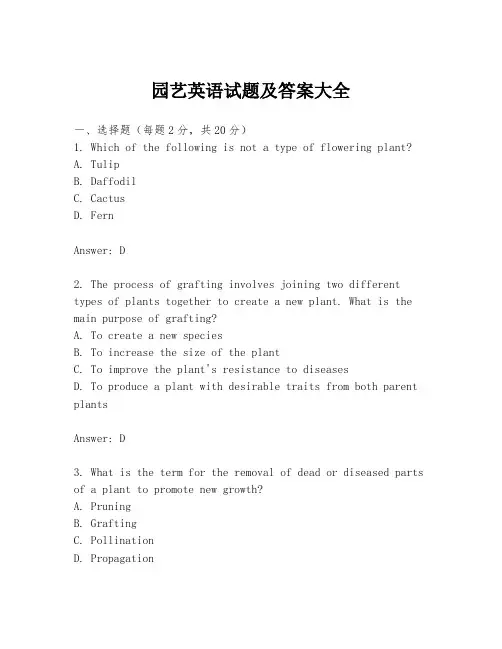
园艺英语试题及答案大全一、选择题(每题2分,共20分)1. Which of the following is not a type of flowering plant?A. TulipB. DaffodilC. CactusD. FernAnswer: D2. The process of grafting involves joining two different types of plants together to create a new plant. What is the main purpose of grafting?A. To create a new speciesB. To increase the size of the plantC. To improve the plant's resistance to diseasesD. To produce a plant with desirable traits from both parent plantsAnswer: D3. What is the term for the removal of dead or diseased parts of a plant to promote new growth?A. PruningB. GraftingC. PollinationD. PropagationAnswer: A4. Which of the following is not a tool commonly used in gardening?A. TrowelB. SecateursC. HoeD. WrenchAnswer: D5. What is the term for a plant that completes its life cycle in one growing season?A. PerennialB. BiennialC. AnnualD. ShrubAnswer: C6. What is the primary function of a greenhouse in gardening?A. To provide shadeB. To protect plants from pestsC. To extend the growing seasonD. To provide additional waterAnswer: C7. What is the term for a plant that lives for more than two years and continues to grow and flower year after year?A. AnnualB. PerennialC. BiennialD. ShrubAnswer: B8. Which of the following is not a type of fertilizer?A. OrganicB. InorganicC. NaturalD. SyntheticAnswer: C9. What is the term for the process by which plants produce flowers?A. GerminationB. BloomingC. PollinationD. FruitingAnswer: B10. What is the term for a plant that is grown for its leaves rather than its flowers or fruits?A. OrnamentalB. HerbaceousC. FoliageD. VegetableAnswer: C二、填空题(每题2分,共20分)1. The root system of a plant that has a single main root and several smaller roots is called a _______ root system. Answer: taproot2. The process of transferring a plant from a smaller container to a larger one is called _______.Answer: transplanting3. A plant that is grown for its seeds is called a _______. Answer: seedling4. The part of the plant that contains the seeds is called the _______.Answer: fruit5. The process of preparing soil for planting is called_______.Answer: tilling6. A plant that is grown for its edible roots is called a_______.Answer: root crop7. The process of encouraging a plant to grow in a certain direction is called _______.Answer: training8. The process of removing weeds from a garden is called_______.Answer: weeding9. The process of watering plants to ensure they receive adequate moisture is called _______.Answer: irrigation10. A plant that is grown for its flowers is called an_______.Answer: ornamental三、简答题(每题10分,共40分)1. Explain the difference between a perennial and an annual plant.Answer: Perennial plants are those that live for more thantwo years and continue to grow and flower year after year. Annual plants, on the other hand, complete their life cyclein one growing season and must be replanted each year.2. Describe the benefits of using organic fertilizers in gardening.Answer: Organic fertilizers provide nutrients to plants in a form that is readily available and can improve soil structure. They also help to support beneficial soil microorganisms, which can lead to healthier plants and a more sustainable garden ecosystem.3. What are the steps involved in the process of propagationby cuttings?Answer: The steps involved in propagation by cuttings include selecting a healthy plant, taking a cutting with at least one node, preparing a rooting medium, inserting the cutting intothe medium, and providing the right conditions for root development.4. Discuss the importance of pruning in maintaining the health and appearance of a garden.Answer: Pruning is essential for maintaining the health and appearance of a garden as it helps to control the size and shape of plants, removes dead or diseased parts, and encourages new growth. Regular pruning can also improve air circulation and reduce the risk of pests and diseases.四、论述题(20分)Discuss the role of garden design in creating a visually appealing and functional outdoor space.Answer: Garden design plays a crucial role in creating a visually appealing and functional outdoor。
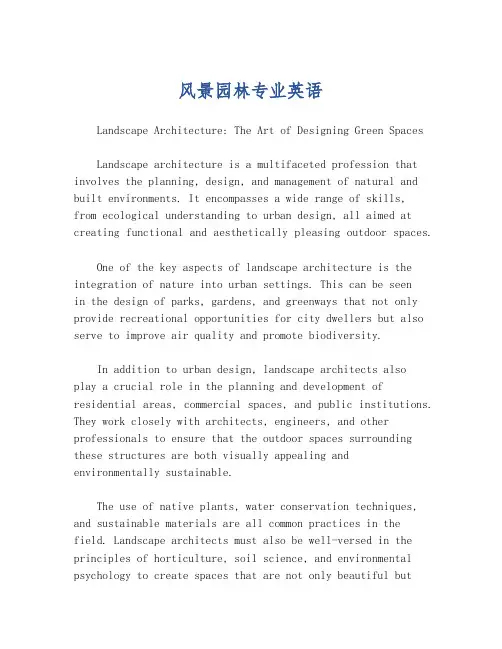
风景园林专业英语Landscape Architecture: The Art of Designing Green SpacesLandscape architecture is a multifaceted profession that involves the planning, design, and management of natural and built environments. It encompasses a wide range of skills,from ecological understanding to urban design, all aimed at creating functional and aesthetically pleasing outdoor spaces.One of the key aspects of landscape architecture is the integration of nature into urban settings. This can be seenin the design of parks, gardens, and greenways that not only provide recreational opportunities for city dwellers but also serve to improve air quality and promote biodiversity.In addition to urban design, landscape architects alsoplay a crucial role in the planning and development of residential areas, commercial spaces, and public institutions. They work closely with architects, engineers, and other professionals to ensure that the outdoor spaces surrounding these structures are both visually appealing and environmentally sustainable.The use of native plants, water conservation techniques, and sustainable materials are all common practices in the field. Landscape architects must also be well-versed in the principles of horticulture, soil science, and environmental psychology to create spaces that are not only beautiful butalso healthy and functional.Education in landscape architecture typically begins with a bachelor's degree in the field, followed by a period of internship and the passage of a licensing exam. Continuing education is also a critical component, as the field is constantly evolving with new technologies and design philosophies.As the world becomes more urbanized and the need for sustainable living spaces grows, the role of the landscape architect is more important than ever. They are the stewards of the environment, working to create a harmonious balance between human habitation and the natural world.。
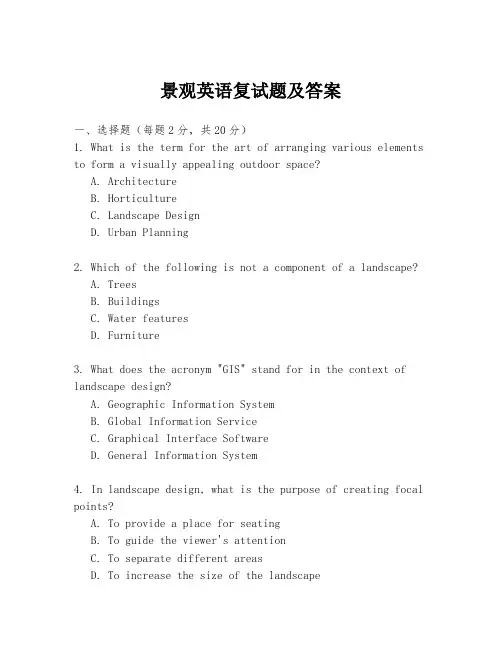
景观英语复试题及答案一、选择题(每题2分,共20分)1. What is the term for the art of arranging various elements to form a visually appealing outdoor space?A. ArchitectureB. HorticultureC. Landscape DesignD. Urban Planning2. Which of the following is not a component of a landscape?A. TreesB. BuildingsC. Water featuresD. Furniture3. What does the acronym "GIS" stand for in the context of landscape design?A. Geographic Information SystemB. Global Information ServiceC. Graphical Interface SoftwareD. General Information System4. In landscape design, what is the purpose of creating focal points?A. To provide a place for seatingB. To guide the viewer's attentionC. To separate different areasD. To increase the size of the landscape5. What is the term used to describe the process of planting trees and shrubs to create a natural barrier?A. AfforestationB. DeforestationC. ReforestationD. Transplantation6. Which of the following is an example of a hardscape element?A. Flower bedsB. LawnsC. Paving stonesD. Shrubs7. What is the primary function of a retaining wall in landscape design?A. To provide a place for seatingB. To create a visual barrierC. To prevent soil erosionD. To increase the height of the terrain8. What is the term for the practice of using native plantsin a landscape design?A. Exotic plantingB. Invasive plantingC. Native plantingD. Non-native planting9. Which of the following is a principle of landscape design?A. SymmetryB. AsymmetryC. MonotonyD. Chaos10. What is the term used to describe the use of plants to create a sense of enclosure?A. ScreeningB. LayeringC. FocalizationD. Containment二、填空题(每题2分,共20分)11. The process of selecting plants for a landscape design is known as _____________.12. A landscape that is designed to be visually pleasing froma specific viewpoint is called a _____________ landscape.13. The use of contrasting colors in a landscape design is an example of the principle of _____________.14. In landscape design, the term "hardscape" refers to elements that are not _____________.15. A _____________ is a landscape element that is used to control the flow of water.16. The practice of designing a landscape to be sustainable and environmentally friendly is known as _____________.17. A landscape that is designed to be visually interesting from all angles is called a _____________ landscape.18. The process of designing a landscape to be accessible to people with disabilities is known as _____________.19. The use of plants to create a sense of depth in a landscape is an example of the principle of _____________. 20. A landscape that is designed to be visually interestingat different times of the year is called a _____________ landscape.三、简答题(每题10分,共30分)21. Explain the importance of considering the microclimate when designing a landscape.22. Describe the role of pathways in a landscape design.23. Discuss the benefits of using native plants in a landscape design.四、论述题(每题30分,共30分)24. Compare and contrast the different approaches to landscape design, such as formal and informal styles. Provide examples to support your discussion.答案:一、选择题1. C2. D3. A4. B5. A6. C7. C8. C9. A10. A二、填空题11. Plant selection12. Focal point13. Contrast14. Living15. Drainage ditch16. Sustainable landscape design17. Multi-view18. Inclusive design19. Perspective20. Four-season三、简答题21. Considering the microclimate is important in landscape design because it affects the growth and survival of plants. It includes factors such as temperature, humidity, and wind patterns, which can influence the choice of plant species and their placement within the landscape.22. Pathways in a landscape design serve as circulation routes, guiding visitors through the space and connecting different areas. They also contribute to the aesthetic appeal and functionality of the landscape.23. Using native plants in a landscape design is beneficial because these plants are well-adapted to the local environment, requiring less maintenance and resources. They also support local ecosystems by providing habitat。
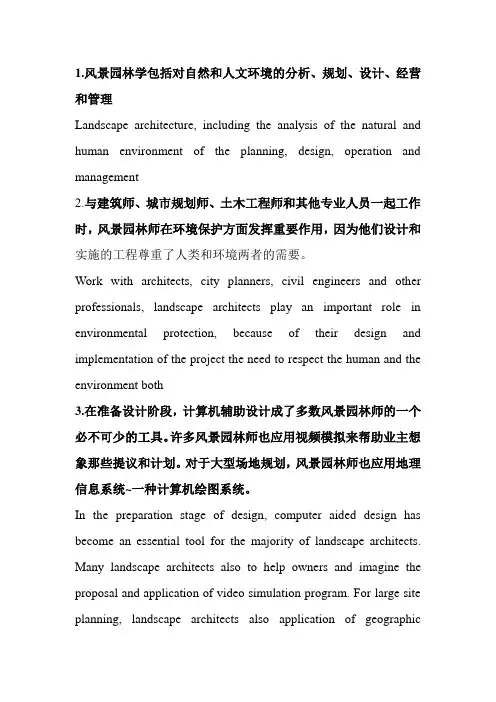
1.风景园林学包括对自然和人文环境的分析、规划、设计、经营和管理Landscape architecture, including the analysis of the natural and human environment of the planning, design, operation and management2.与建筑师、城市规划师、土木工程师和其他专业人员一起工作时,风景园林师在环境保护方面发挥重要作用,因为他们设计和实施的工程尊重了人类和环境两者的需要。
Work with architects, city planners, civil engineers and other professionals, landscape architects play an important role in environmental protection, because of their design and implementation of the project the need to respect the human and the environment both3.在准备设计阶段,计算机辅助设计成了多数风景园林师的一个必不可少的工具。
许多风景园林师也应用视频模拟来帮助业主想象那些提议和计划。
对于大型场地规划,风景园林师也应用地理信息系统~一种计算机绘图系统。
In the preparation stage of design, computer aided design has become an essential tool for the majority of landscape architects. Many landscape architects also to help owners and imagine the proposal and application of video simulation program. For large site planning, landscape architects also application of geographicinformation system ~ a computer drawing system.4.园林本科核心课程围绕一系列设计室课程展开,设计室教学需要学生与老师结成一对一的关系。
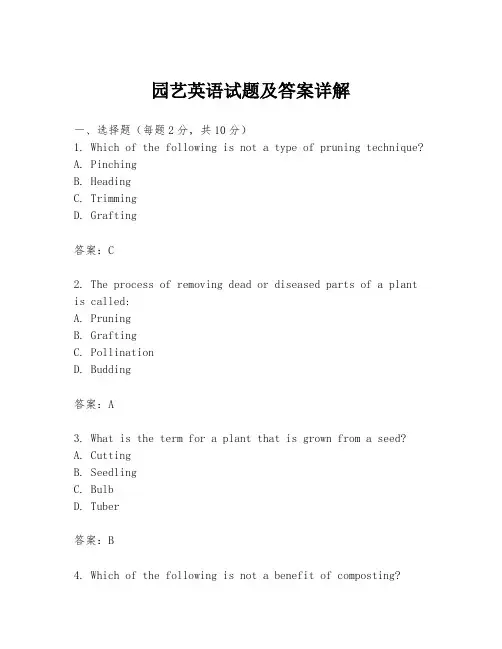
园艺英语试题及答案详解一、选择题(每题2分,共10分)1. Which of the following is not a type of pruning technique?A. PinchingB. HeadingC. TrimmingD. Grafting答案:C2. The process of removing dead or diseased parts of a plant is called:A. PruningB. GraftingC. PollinationD. Budding答案:A3. What is the term for a plant that is grown from a seed?A. CuttingB. SeedlingC. BulbD. Tuber答案:B4. Which of the following is not a benefit of composting?A. Reduces wasteB. Improves soil structureC. Increases soil salinityD. Provides nutrients for plants答案:C5. What is the term for a plant that is grown from a part of the plant itself, such as a stem or leaf?A. SeedlingB. CuttingC. BulbD. Rhizome答案:B二、填空题(每题2分,共10分)1. The main parts of a flower are the __________, petals, and stamen.答案:reproductive2. A __________ is a type of plant propagation where a new plant is grown from a part of the parent plant.答案:cutting3. The process of converting sunlight into chemical energy that can be used by plants is called __________.答案:photosynthesis4. __________ is the practice of growing plants in a controlled environment, such as a greenhouse.答案:Hydroponics5. The __________ is the underground part of a plant that stores food and nutrients.答案:root三、简答题(每题10分,共20分)1. Explain the difference between annuals and perennials.答案:Annuals are plants that complete their life cycle inone growing season, while perennials are plants that live for more than two years and return year after year.2. Describe the role of fertilizers in plant growth.答案:Fertilizers provide essential nutrients to plants,which are necessary for their growth and development. They contain elements like nitrogen, phosphorus, and potassium, which help in leaf growth, root development, and overallplant health.四、论述题(每题15分,共30分)1. Discuss the importance of watering plants appropriatelyand how it affects plant health.答案:Watering plants appropriately is crucial for theirhealth as it directly affects their growth, development, and overall survival. Overwatering can lead to root rot and other diseases, while underwatering can cause wilting and stunted growth. The right amount of water, along with proper drainage, ensures that plants receive the necessary hydration without being subjected to waterlogged conditions.2. Explain the concept of plant hardiness and itssignificance in gardening.答案:Plant hardiness refers to a plant's ability to withstand cold temperatures without damage. It is a significant factor in gardening as it helps gardeners choose plants that are suitable for their region's climate. Understanding a plant's hardiness zone allows for successful cultivation and prevents the loss of plants due to temperature extremes.。
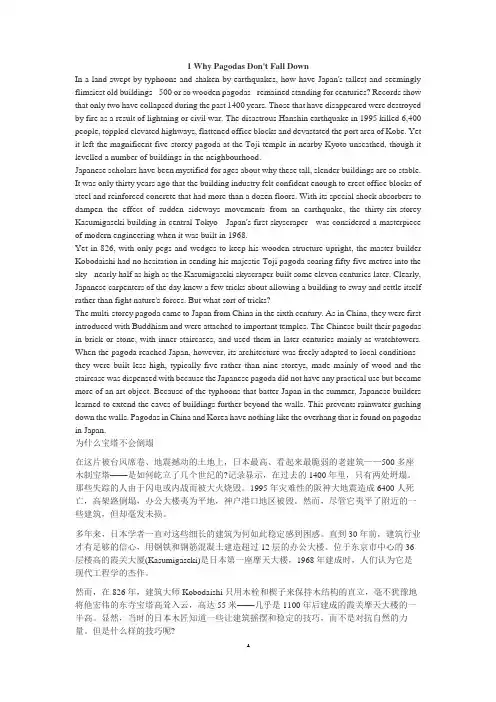
1 Why Pagodas Don't Fall DownIn a land swept by typhoons and shaken by earthquakes, how have Japan's tallest and seemingly flimsiest old buildings - 500 or so wooden pagodas - remained standing for centuries? Records show that only two have collapsed during the past 1400 years. Those that have disappeared were destroyed by fire as a result of lightning or civil war. The disastrous Hanshin earthquake in 1995 killed 6,400 people, toppled elevated highways, flattened office blocks and devastated the port area of Kobe. Yet it left the magnificent five-storey pagoda at the Toji temple in nearby Kyoto unscathed, though it levelled a number of buildings in the neighbourhood.Japanese scholars have been mystified for ages about why these tall, slender buildings are so stable. It was only thirty years ago that the building industry felt confident enough to erect office blocks of steel and reinforced concrete that had more than a dozen floors. With its special shock absorbers to dampen the effect of sudden sideways movements from an earthquake, the thirty-six-storey Kasumigaseki building in central Tokyo - Japan's first skyscraper - was considered a masterpiece of modern engineering when it was built in 1968.Yet in 826, with only pegs and wedges to keep his wooden structure upright, the master builder Kobodaishi had no hesitation in sending his majestic Toji pagoda soaring fifty-five metres into the sky - nearly half as high as the Kasumigaseki skyscraper built some eleven centuries later. Clearly, Japanese carpenters of the day knew a few tricks about allowing a building to sway and settle itself rather than fight nature's forces. But what sort of tricks?The multi-storey pagoda came to Japan from China in the sixth century. As in China, they were first introduced with Buddhism and were attached to important temples. The Chinese built their pagodas in brick or stone, with inner staircases, and used them in later centuries mainly as watchtowers. When the pagoda reached Japan, however, its architecture was freely adapted to local conditions - they were built less high, typically five rather than nine storeys, made mainly of wood and the staircase was dispensed with because the Japanese pagoda did not have any practical use but became more of an art object. Because of the typhoons that batter Japan in the summer, Japanese builders learned to extend the eaves of buildings further beyond the walls. This prevents rainwater gushing down the walls. Pagodas in China and Korea have nothing like the overhang that is found on pagodas in Japan.为什么宝塔不会倒塌在这片被台风席卷、地震撼动的土地上,日本最高、看起来最脆弱的老建筑——500多座木制宝塔——是如何屹立了几个世纪的?记录显示,在过去的1400年里,只有两处坍塌。
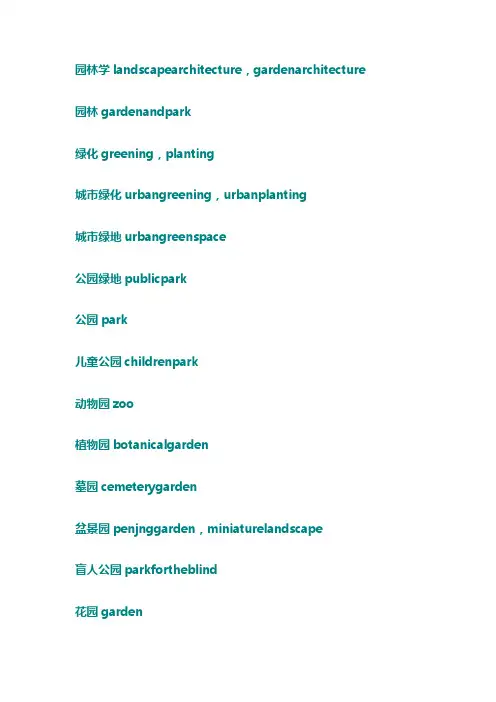
园林学landscapearchitecture,gardenarchitecture 园林gardenandpark绿化greening,planting城市绿化urbangreening,urbanplanting城市绿地urbangreenspace公园绿地publicpark公园park儿童公园childrenpark动物园zoo植物园botanicalgarden墓园cemeterygarden盆景园penjnggarden,miniaturelandscape盲人公园parkfortheblind花园garden历史名园historicalgardenandpark风景名胜公园famousscenicpark纪念公园memorialpark街旁绿地roadsidegreenspace带状公园linearpark专类公园themepark岩石园rockgarden社区公园communitypark生产绿地productiveplantationarea防护绿地greenbuffer,greenareaforenvironmentalprotection附属绿地attachedgreenspace居住绿地greenspaceattachedtohousingestate,residentialgreenspace道路绿地greenspaceattachedtourbanroadandsquare屋顶花园roofgarden立体绿化verticalplanting风景林地scenicforestland城市绿地系统urbangreenspacesystem城市绿地系统规划urbangreenspacesystemplanning 绿化覆盖面积greencoverage绿化覆盖率percentageofgreenerycoverage绿地率greeningrate,ratioofgreenspace绿带greenbelt楔形绿地greenwedge城市绿线boundarylineofurbangreenspace园林史landscapehistory,gardenhistory古典园林classicalgarden囿huntingpark苑imperialpark皇家园林royalgarden私家园林privategarden寺庙园林monasterygarden园林艺术gardenart相地siteinvestigation造景landscaping借景borrowedscencry,viewborrowing园林意境poeticimagcryofgarden透景线perspectiveline盆景miniaturelandscape,penjing插花flowerarrangement季相seasonalappearanceofplant园林规划gardenplanning,landscapingplanning园林布局gardenlayout园林设计gardendesign公园最大游人量maximumvisitorscapacityinpark 地形设计topographicaldesign园路设计gardenpathdesign种植设计plantingdesign孤植specimenplanting,isolatedplanting对植Oppositeplanting,coupledplanting列植linearplanting群植groupplanting,massplanting园林植物landscapeplant观赏植物ornamentalplant古树名木historicaltreeandfamouswoodspecies 地被植物groundcoverplant攀缘植物climbingplant,climber温室植物greenhouseplant花卉floweringplant行道树avenuetree,streettree草坪lawn绿篱hedge花篱flowerhedge花境flowerborder人工植物群落man-madeplantinghabitat 园林建筑gardenbuilding园林小品smallgardenornaments园廊veranda,gallery,colonnade水榭watersidepavilion舫boathouse园亭gardenpavilion,pavilion园台platform月洞门moongate花架pergola,trellis园林楹联coupletwrittenonscroll,coupletonpillar 园林匾额bian'eingarden园林工程gardenengineering绿化工程plantengineering大树移植bigtreetransplanting假植heelingin,temporaryplanting基础种植foundationplanting种植成活率ratiooflivingtree适地适树plantingaccordingtotheenvironment造型修剪topiary园艺horticulture假山rockwork,artificialhill置石stonearrangement,stonelayout掇山piledstonehill,hillmaking塑山man-maderockwork园林理水watersystemlayoutingarden驳岸revetmentingarden喷泉fountain风景名胜区landscapeandfamousscenery国家重点风景名胜区nationalparkofChina风景名胜区规划landscapeandfamoussceneryplanning 风景名胜famousscenery,famousscenicsite风景资源sceneryresource景物view,feature景点featurespot,viewspot景区sceniczone景观landscape,scenery游览线touringroute环境容量environmentalcapacity 国家公园nationalpark。
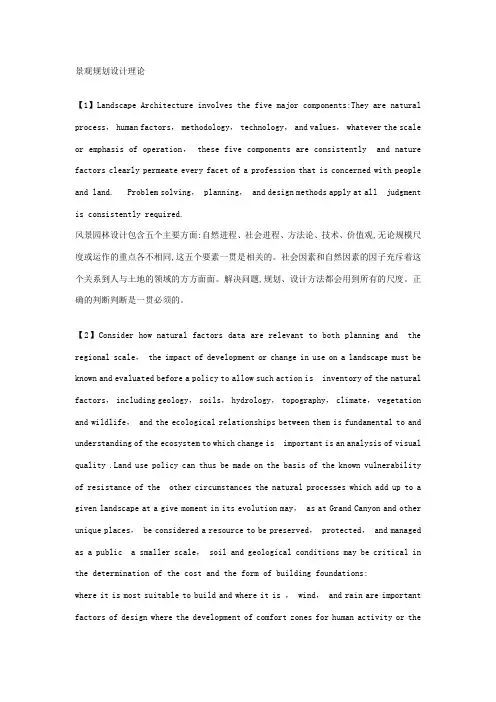
景观规划设计理论【1】Landscape Architecture involves the five major components:They are natural process, human factors, methodology, technology, and values, whatever the scale or emphasis of operation, these five components are consistently and nature factors clearly permeate every facet of a profession that is concerned with people and land. Problem solving, planning, and design methods apply at all judgment is consistently required.风景园林设计包含五个主要方面:自然进程、社会进程、方法论、技术、价值观,无论规模尺度或运作的重点各不相同,这五个要素一贯是相关的。
社会因素和自然因素的因子充斥着这个关系到人与土地的领域的方方面面。
解决问题,规划、设计方法都会用到所有的尺度。
正确的判断判断是一贯必须的。
【2】Consider how natural factors data are relevant to both planning and the regional scale, the impact of development or change in use on a landscape must be known and evaluated before a policy to allow such action is inventory of the natural factors, including geology, soils, hydrology, topography, climate, vegetation and wildlife, and the ecological relationships between them is fundamental to and understanding of the ecosystem to which change is important is an analysis of visual quality .Land use policy can thus be made on the basis of the known vulnerability of resistance of the other circumstances the natural processes which add up to a given landscape at a give moment in its evolution may, as at Grand Canyon and other unique places, be considered a resource to be preserved, protected, and managed as a public a smaller scale, soil and geological conditions may be critical in the determination of the cost and the form of building foundations:where it is most suitable to build and where it is , wind, and rain are important factors of design where the development of comfort zones for human activity or thegrowth of plants is a primary ,in many ways natural factors influence land use,site planning, and detailer design.自然因素的考虑与规划和设计都有关系。
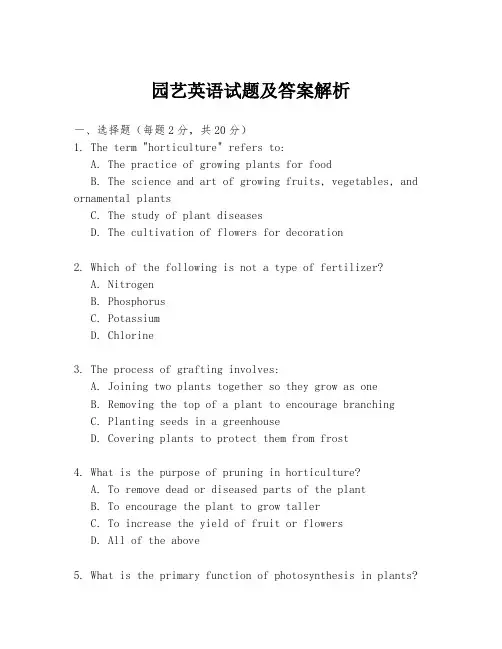
园艺英语试题及答案解析一、选择题(每题2分,共20分)1. The term "horticulture" refers to:A. The practice of growing plants for foodB. The science and art of growing fruits, vegetables, and ornamental plantsC. The study of plant diseasesD. The cultivation of flowers for decoration2. Which of the following is not a type of fertilizer?A. NitrogenB. PhosphorusC. PotassiumD. Chlorine3. The process of grafting involves:A. Joining two plants together so they grow as oneB. Removing the top of a plant to encourage branchingC. Planting seeds in a greenhouseD. Covering plants to protect them from frost4. What is the purpose of pruning in horticulture?A. To remove dead or diseased parts of the plantB. To encourage the plant to grow tallerC. To increase the yield of fruit or flowersD. All of the above5. What is the primary function of photosynthesis in plants?A. To produce oxygenB. To convert sunlight into energy for growthC. To absorb water from the soilD. To store nutrients for later use6. The term "biennial" describes a plant that:A. Lives for two yearsB. Produces flowers every two yearsC. Grows twice as fast as other plantsD. Requires two seasons to complete its life cycle7. Which of the following is a common method of plant propagation?A. Seed sowingB. Tissue cultureC. Both A and BD. None of the above8. What is the role of the cambium in a tree?A. To transport water and nutrientsB. To provide structural supportC. To produce new cells for growthD. To protect the tree from pests9. The pH scale ranges from:A. 0 to 14B. 1 to 10C. 2 to 12D. 3 to 1310. What is the purpose of mulching in a garden?A. To improve soil aerationB. To retain moisture and regulate soil temperatureC. To provide a decorative effectD. To increase the soil's pH level二、填空题(每题1分,共10分)11. The scientific classification of plants is known as__________.12. A plant that is grown for its leaves rather than its flowers is called a __________.13. The process by which plants absorb water and nutrients is called __________.14. The primary component of natural gas is __________.15. A plant that is adapted to grow in dry conditions is known as a __________.16. The root system of a plant that is adapted to absorb water in arid conditions is called __________.17. The process of a plant changing from vegetative growth to reproductive growth is called __________.18. The study of the effects of environmental factors on organisms is called __________.19. A plant that is grown for its edible seeds is known as a __________.20. The process of a plant adapting to its environment is called __________.三、简答题(每题5分,共20分)21. Explain the difference between annual and perennial plants.22. Describe the process of photosynthesis in simple terms.23. What are the benefits of companion planting in a garden?24. Discuss the importance of soil testing in horticulture.四、论述题(每题15分,共30分)25. Discuss the role of horticulture in sustainable agriculture.26. Explain the significance of plant breeding in modern horticulture.五、答案解析1. B - Horticulture is the science and art of growing fruits, vegetables, and ornamental plants.2. D - Chlorine is not a type of fertilizer; it is a chemical element.3. A - Grafting is the process of joining two plants together so they grow as one.4. D - Pruning serves multiple purposes, including removing dead or diseased parts, encouraging growth, and increasing yield.5. B - Photosynthesis is the process by which plants convert sunlight into energy for growth.6. D - A biennial completes its life cycle over two growing seasons.7. C - Both seed sowing and tissue culture are common methods of plant propagation.8. C - The cambium produces new cells for growth in a tree.9. A - The pH scale ranges from 0 to 14, with 7 being neutral.10. B - Mulching helps retain moisture and regulate soil temperature.11.。
园艺英语试题类型及答案一、选择题(每题1分,共10分)1. Which of the following is a common garden tool?A. ShovelB. ForkC. Both A and B2. The term "photosynthesis" refers to the process by which plants:A. Absorb sunlightB. Convert light energy into chemical energyC. Release oxygen3. What is the primary function of fertilizers in gardening?A. To provide waterB. To provide nutrientsC. To control pests4. The scientific name for a rose is:A. RosaB. TulipaC. Dendranthema5. What is the correct term for the process of a plant producing flowers?A. GerminationB. BloomingC. Pollination6. Which of the following is a type of pruning technique?A. PinchingB. GraftingC. Layering7. What is the purpose of mulching in a garden?A. To increase soil temperatureB. To reduce weed growthC. To improve soil aeration8. The term "perennial" refers to a plant that:A. Lives for one seasonB. Lives for two or more yearsC. Produces flowers annually9. What is the role of a greenhouse in gardening?A. To provide shadeB. To extend the growing seasonC. To store tools10. The process of "grafting" involves:A. Joining two plants togetherB. Removing unwanted branchesC. Planting seeds答案:1-5 C, B, B, A, B; 6-10 A, B, B, B, A二、填空题(每空1分,共10分)1. The basic components of soil include ______, ______, water, and air.2. The term "biennial" refers to a plant that completes its life cycle in ______ years.3. In gardening, the process of "thinning" involves removing excess ______ to allow for better growth.4. A "compost pile" is a place where organic waste is decomposed into a nutrient-rich material known as ______.5. The "trellis" is a structure used to support climbing plants and is often made of ______ or wood.答案:1. minerals, organic matter; 2. two; 3. plants; 4. compost; 5. metal三、简答题(每题5分,共20分)1. 描述园艺中“轮作”的概念及其重要性。
中考英语园艺景观设计单选题40题1. A gardener wants to plant some ____ in the garden. They can bloom beautifully in spring.A. rosesB. stonesC. plasticsD. metals答案解析:A。
“roses”(玫瑰)是植物,适合种植在花园里并且在春天能美丽地开花。
“stones”((石头)、“plastics”((塑料)和“metals”(金属)都不是植物,不能在花园里种植并开花,所以不能选。
2. The ____ in the corner of the garden is growing very tall. It needs to be cut.A. grassB. bookC. carD. house答案解析:A。
“grass”(草)是生长在花园里的植物,如果长得很高就需要修剪。
“book”((书)、“car”((汽车)和“house”((房子)都不是植物,与园艺场景无关,所以不选。
3. Which of the following plants can climb up the fence?A. IvyB. DeskC. ChairD. Lamp答案解析:A。
“Ivy”((常春藤)是一种可以攀爬篱笆的植物。
“desk”(书桌)、“chair”((椅子)和“lamp”((灯)都不是植物,不能攀爬篱笆,所以选A。
4. The gardener noticed that the ____ were withering because of the lack of water.A. flowersB. cloudsC. starsD. moons答案解析:A。
“flowers”(花朵)在缺水的情况下会枯萎,这是符合园艺常识的。
“clouds”((云)、“stars”((星星)和“moons”((月亮)都不是植物,不会因为缺水而枯萎,所以选A。
中考英语园艺景观设计单选题40题1. In the garden, we often use a ____ to cut branches.A.spadeB.rakeC.shearsD.watering can答案:C。
选项A“spade”是铲子;选项B“rake”是耙子;选项C“shears”是大剪刀,可用来剪树枝;选项D“watering can”是喷壶。
题目中说在花园里用来剪树枝的工具,所以是shears。
2. When we need to dig holes in the garden, we can use a ____.A.hoeB.broomC.scissorsD.seed答案:A。
选项A“hoe”是锄头,可用来挖洞;选项B“broom”是扫帚;选项C“scissors”是剪刀;选项D“seed”是种子。
题目中说在花园里挖洞用的工具,所以是hoe。
3. A ____ is used to water plants in the garden.A.hammerB.sawC.watering canD.pliers答案:C。
选项A“hammer”是锤子;选项B“saw”是锯子;选项C“watering can”是喷壶,可用来给植物浇水;选项D“pliers”是钳子。
题目中说在花园里给植物浇水用的工具,所以是watering can。
4. We use a ____ to clean up leaves in the garden.A.bucketB.shovelC.rakeD.trowel答案:C。
选项A“bucket”是桶;选项B“shovel”是铲子;选项C“rake”是耙子,可用来清理花园里的树叶;选项D“trowel”是泥铲。
题目中说在花园里清理树叶用的工具,所以是rake。
5. A ____ is helpful for planting small seeds.A.trowelB.spoonC.forkD.knife答案:A。
中考英语园艺景观设计单选题40题1.There are many beautiful flowers in the garden. The roses are red and the lilies are white. The leaves of the plants are ____.A.greenB.blueC.yellowD.purple答案:A。
在园艺景观中,植物的叶子通常是绿色的。
选项B“blue”蓝色、选项C“yellow”黄色、选项D“purple”紫色都不符合一般植物叶子的颜色。
2.The tulips in the garden are very ____.A.tallB.shortC.beautifulD.ugly答案:C。
郁金香通常是很美丽的。
选项A“tall”高的、选项B“short”矮的不太能准确描述郁金香普遍的特点。
选项D“ugly”丑陋的不符合郁金香的外观特征。
3.In the landscape design, the sunflowers are ____.A.smallB.bigC.thinD.fat答案:B。
向日葵通常是比较大的。
选项A“small”小的不符合向日葵的大小特点。
选项C“thin”瘦的和选项D“fat”胖的也不适合形容向日葵。
4.The leaves of the maple trees in the garden are ____.A.roundB.squareC.ovalD.triangular答案:C。
枫叶通常是椭圆形的。
选项A“round”圆形的、选项B“square”方形的、选项D“triangular”三角形的都不符合枫叶的形状。
5.The daisies in the garden are ____.A.strongB.weakC.lovelyD.terrible答案:C。
雏菊通常是可爱的。
选项A“strong”强壮的、选项B“weak”虚弱的不太适合形容雏菊。
风景园林英语唐明辉答案【作业】Unit 1 Landscape architects and landscape architecture Assignment for Unit 11、问题:风景园林设计是对户外公共区域、地标和建筑进行的设计。
在设计中要对景观中现有的社会、生态和土壤条件等进行系统调查并实行一些干预措施,以实现环境、社会行为( social-behavioral )及审美的融合,并确保所有的设计计划符合所在国家及地方的建筑规范( building codes )和条例( ordinances )。
该领域包括景观设计、场地规划、雨水管理、环境恢复、公园和游憩区域规划、视觉资源管理、绿色基础设施的规划和提供、私人住宅和住宅景观总体规划和设计等。
风景园林行业的从业者被称为风景园林设计师。
评分规则: 【 2分—条理不清,思路紊乱,语言支离破碎或大部分句子均有错误,且多数为严重错误。
5分—连贯性差。
有较多的严重语言错误。
8分—文字勉强连贯;语言错误相当多,其中有一些是严重错误。
11分—文字连贯,但有少量语言错误。
14分—文字顺通、连贯,基本上无语言错误,仅有个别小错。
】Unit 1 Landscape architects and landscapearchitecture Test for Unit 11、问题:To follow the new trend of thought, these designers are striving to turnthe _ into an outdoor eco-lab.选项:A:arboretumB:vegetationC:fountainD:architecture答案: 【arboretum】2、问题:Chilly outside, tourists found it amazing that the inn had a garden ofsemi-tropical ___ .选项:A:vegetationB:arboretumC:drainageD:forest答案: 【vegetation】3、问题:Experts can combine pictures taken from airplanes and satellites with _data.选项:A:landfillB:topographicalC:municipalD:degraded答案: 【topographical】4、问题:Today’s complex artificial landscape requires close teamwork betweenthe ___ and the designers.选项:A:professionalsB:bossC:forestersD:workers答案: 【foresters】5、问题:The ____ system here, including a water-closet, is of the mostcomplete and modern kind.选项:A:climateB:topographicalC:waterD:drainage答案: 【drainage】6、问题:The town was a seaside __ in the North-eastof England,which has been over-exploited these years.选项:A:resortB:placeC:projectD:site答案: 【resort】7、问题:Environmentalists protested against the current plan because theysay there is a high risk of pollution from the ___ site.选项:A:landfillB:wasteC:pollutedD:mine答案: 【landfill】8、问题:As response to the public, the new __ authorities have keptthe landscape up well.选项:A:municipalityB:cityC:municipalD:urban答案: 【municipal】9、问题:The proposal of the project that I have been involved ___ is now approved.选项:A:inB:intoC:withD:at答案: 【with】10、问题:Modern construction increasingly depends on ___ with environmental regulations, land-use zoning and water restrictions.选项:A:competitionB:compositionC:complexD:compliance答案: 【compliance】11、问题:In planning a site, landscape architects will follow following steps:选项:A:study and analyze the siteB:prepare a preliminary designC:propare a proposal for the clientD:prepare working drawings答案: 【study and analyze the site;prepare a preliminary design;propare a proposal for the client;prepare working drawings】12、问题: The work of landscape architects will play an increasingly important role in shaping the world’s future by making a positive impact on:选项:A:economicB:educationC:healthD:social答案: 【economic;health】13、问题:Landscape architects may work in :选项:A:regional planning and resource managementB:site constructionC:cost studiesD:planting trees答案: 【regional planning and resource management;site construction;cost studies】14、问题:Landscape architects plan and design some sites, such as __.选项:A:therapeutic gardensB:cemeteriesC:institutional centersD:historical landscape答案: 【therapeutic gardens;cemeteries;institutional centers;historical landscape】15、问题:When landscape architects study and analyze the site, they have to consider the following natural elements: _选项:A:climateB:existing facilitiesC:sunlightD:soilE:vegetationF:fund available答案: 【climate;existing facilities;sunlight;soil;vegetation】16、问题:Landscape architects work at design of the naural environment only.选项:A:正确B:错误答案: 【错误】17、问题:Landscape achitects plan and design both traditional places and environmental remediation.选项:A:正确B:错误答案: 【错误】18、问题:A wide range of opportunities are open tolandscape architects today because they can earn much money.选项:A:正确B:错误答案: 【错误】19、问题:Landscape architects work with many other professionals, so they have to be good at communication.选项:A:正确B:错误答案: 【正确】20、问题:As a student majoring in landscape architecture, CAD and GIS are necessary.选项:A:正确B:错误答案: 【正确】21、问题:According to surveys of ASLA, landscape architecture firms have been in difficulty since the 2008 Crash.选项:A:正确B:错误答案: 【错误】22、问题:Preparing a proposal for the client, landscape architects need to produce construction details.选项:A:正确B:错误答案: 【错误】。
1 Why Pagodas Don't Fall DownIn a land swept by typhoons and shaken by earthquakes, how have Japan's tallest and seemingly flimsiest old buildings - 500 or so wooden pagodas - remained standing for centuries? Records show that only two have collapsed during the past 1400 years. Those that have disappeared were destroyed by fire as a result of lightning or civil war. The disastrous Hanshin earthquake in 1995 killed 6,400 people, toppled elevated highways, flattened office blocks and devastated the port area of Kobe. Yet it left the magnificent five-storey pagoda at the Toji temple in nearby Kyoto unscathed, though it levelled a number of buildings in the neighbourhood.Japanese scholars have been mystified for ages about why these tall, slender buildings are so stable. It was only thirty years ago that the building industry felt confident enough to erect office blocks of steel and reinforced concrete that had more than a dozen floors. With its special shock absorbers to dampen the effect of sudden sideways movements from an earthquake, the thirty-six-storey Kasumigaseki building in central Tokyo - Japan's first skyscraper - was considered a masterpiece of modern engineering when it was built in 1968.Yet in 826, with only pegs and wedges to keep his wooden structure upright, the master builder Kobodaishi had no hesitation in sending his majestic Toji pagoda soaring fifty-five metres into the sky - nearly half as high as the Kasumigaseki skyscraper built some eleven centuries later. Clearly, Japanese carpenters of the day knew a few tricks about allowing a building to sway and settle itself rather than fight nature's forces. But what sort of tricks?The multi-storey pagoda came to Japan from China in the sixth century. As in China, they were first introduced with Buddhism and were attached to important temples. The Chinese built their pagodas in brick or stone, with inner staircases, and used them in later centuries mainly as watchtowers. When the pagoda reached Japan, however, its architecture was freely adapted to local conditions - they were built less high, typically five rather than nine storeys, made mainly of wood and the staircase was dispensed with because the Japanese pagoda did not have any practical use but became more of an art object. Because of the typhoons that batter Japan in the summer, Japanese builders learned to extend the eaves of buildings further beyond the walls. This prevents rainwater gushing down the walls. Pagodas in China and Korea have nothing like the overhang that is found on pagodas in Japan.为什么宝塔不会倒塌在这片被台风席卷、地震撼动的土地上,日本最高、看起来最脆弱的老建筑——500多座木制宝塔——是如何屹立了几个世纪的?记录显示,在过去的1400年里,只有两处坍塌。
那些失踪的人由于闪电或内战而被大火烧毁。
1995年灾难性的阪神大地震造成6400人死亡,高架路倒塌,办公大楼夷为平地,神户港口地区被毁。
然而,尽管它夷平了附近的一些建筑,但却毫发未损。
多年来,日本学者一直对这些细长的建筑为何如此稳定感到困惑。
直到30年前,建筑行业才有足够的信心,用钢铁和钢筋混凝土建造超过12层的办公大楼。
位于东京市中心的36层楼高的霞关大厦(Kasumigaseki)是日本第一座摩天大楼,1968年建成时,人们认为它是现代工程学的杰作。
然而,在826年,建筑大师Kobodaishi只用木栓和楔子来保持木结构的直立,毫不犹豫地将他宏伟的东寺宝塔高耸入云,高达55米——几乎是1100年后建成的霞关摩天大楼的一半高。
显然,当时的日本木匠知道一些让建筑摇摆和稳定的技巧,而不是对抗自然的力量。
但是什么样的技巧呢?这座多层宝塔于六世纪从中国传入日本。
与中国一样,它们最初是随着佛教传入的,并附属于重要的寺庙。
中国人用砖或石头建造宝塔,里面有楼梯,后来几个世纪主要用作瞭望塔。
宝塔到达日本的时候,然而,其架构是自由地适应当地条件,他们建造了那么高,通常5而不是9层,主要是木材和楼梯是摒弃因为日本宝塔没有任何实际使用但变得更像一个艺术对象。
由于夏季袭击日本的台风,日本建筑商学会了将建筑物的屋檐延伸到墙外更远的地方。
这样可以防止雨水从墙上涌下来。
中国和韩国的宝塔没有像日本宝塔那样的悬挑。
The roof of a Japanese temple building can be made to overhang the sides of the structure by fifty per cent or more of the building's overall width. For the same reason, the builders of Japanese pagodas seem to have further increased their weight by choosing to cover these extended eaves not with the porcelain tiles of many Chinese pagodas but with much heavier earthenware tiles.But this does not totally explain the great resilience of Japanese pagodas. Is the answer that, like a tall pine tree, the Japanese pagoda - with its massive trunk-like central pillar known as shinbashira - simply flexes and sways during a typhoon or earthquake? For centuries, many thought so. But the answer is not so simple because the startling thing is that the Shinbashira actually carries no load at all. In fact, in some pagoda designs, it does not even rest on the ground, but is suspended from the top of the pagoda - hanging loosely down through the middle of the building. The weight of the building is supported entirely by twelve outer and four inner columns.And what is the role of the shinbashira, the central pillar? The best way to understand the Shinbashira's role is to watch a video made by Shuzo Ishida, a structural engineer at Kyoto Institute of Technology. Mr. Ishida, known to his students as 'Professor Pagoda' because of his passion to understand the pagoda, has built a series of models and tested them on a 'shake- table' in his laboratory. In short, the Shinbashira was acting like an enormous stationary pendulum. The ancient craftsmen, apparently without the assistance of very advanced mathematics, seemed to grasp the principles that were, more than a thousand years later, applied in the construction of Japan's first skyscraper. What those early craftsmen had found by trial and error was that under pressure a pagoda's loose stack of floors could be made to slither to and fro independent of one another. Viewed from the side, the pagoda seemed to be doing a snake dance - with each consecutive floor moving in the opposite direction to its neighbours above and below. The shinbashira, running up through a hole in the centre of the building, constrained individual storeys from moving too far because, after moving a certain distance, they banged into it, transmitting energy away along the column. Another strange feature of the Japanese pagoda is that, because the building tapers, with each successive floor plan being smaller than the one below, none of the vertical pillars that carry the weight of the building is connected to its corresponding pillar above. In other words, a five- storey pagoda contains not even one pillar that travels right up through the building to carry the structural loads from the top to the bottom. More surprising is the fact that the individual storeys of a Japanese pagoda, unlike their counterparts elsewhere, are not actually connected to each other. They are simply stacked one on top of another like a pile of hats. Interestingly, such a design would not be permitted under current Japanese building regulations.日本寺庙建筑的屋顶可以使建筑的侧面超出建筑总宽度的50%或更多。